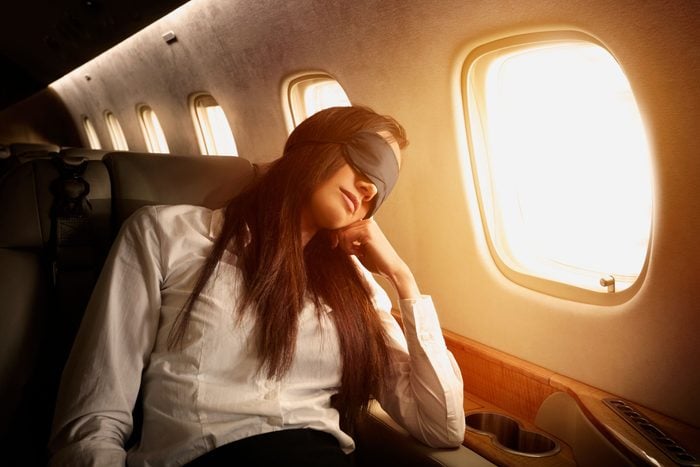
Try these snoozing secrets
When it comes to sleeping during a flight, air travelers usually fall into one of two categories: those who can conk out immediately, and those for whom getting shut-eye is nearly impossible. If you’ve ever looked on with envy at the man blissfully snoring away in the aisle seat, you’ve probably wondered what he knows that you don’t about how to sleep on a plane.
Sleeping during a flight is tricky, thanks to constant noise, a lack of legroom and space and a decline in free amenities. It’s even harder to doze off when you don’t have the best seat on the plane. But drowsy fliers, take heart! I’m a European-based travel writer with many frequent-flier miles under my belt, and I promise, it is possible to sleep on a plane. I asked sleep experts and frequent travelers to share their tested tips for getting some z’s while airborne—and when it might be best to avoid sleep altogether. Until all airlines install bunk beds or other sleep-encouraging hidden airplane features, use these sleepy-time flying hacks for a more restful flight.
Get Reader’s Digest’s Read Up newsletter for travel tips, humor, cleaning, tech and fun facts all week long.
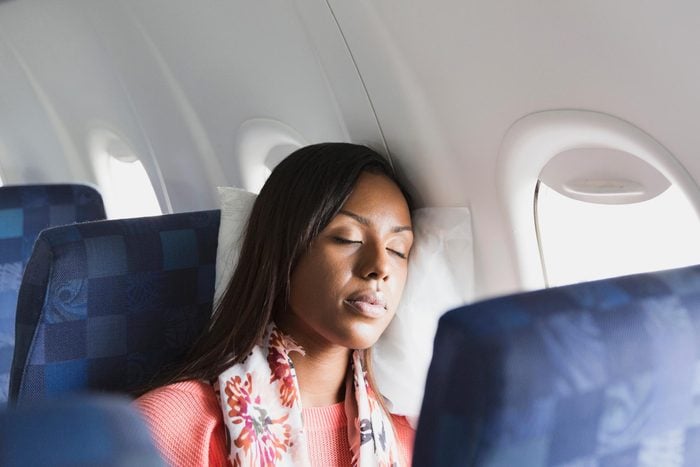
Don’t knock a power nap
“Short-haul flights can be an excellent opportunity to catch up on some well-needed rest, and napping is great for memory and cognitive function,” says general practitioner Caitlin Chasser, a sleep consultant and co-founder of The Sleep Project. Plus, as airplanes climb to cruising altitude, the cabin pressure lowers, meaning the oxygen is slightly less dense than at ground level, which can make you feel sleepy.
Her tip: If you’re tempted to sleep on a shorter flight, keep your nap to less than 20 minutes, and make sure your nap is completed before 3 p.m. “This strategy rejuvenates you without leaving you groggy or sluggish on waking. It shouldn’t impact your ability to fall asleep at your usual bedtime.”
If you don’t feel like sleeping on the plane, “just five minutes of deep relaxation or focused breath work can significantly reduce anxiety and improve your sleep quality.”
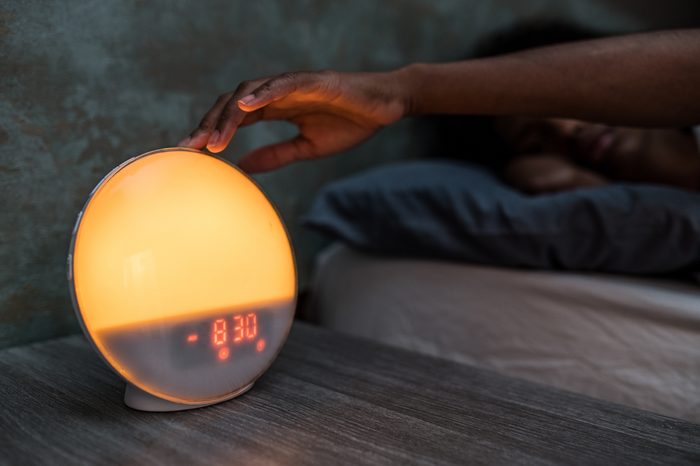
Adjust your inner clock ahead of time
If you’re flying into a new time zone, consider adjusting your sleep schedule a few days before your flight. “When you have to sleep during a flight, you are tinkering with your body’s circadian rhythm, the cycle that your body uses to sleep, metabolize, work and produce energy,” says Neil Paulvin, DO, a New York–based longevity and regenerative medicine specialist. Falling out of this rhythm may cause a number of unwelcome jet lag symptoms, including drowsiness, mood changes, memory loss, fatigue, nausea and poor performance. “[These are] all things you don’t want to be dealing with when crossing into a new city or country,” he says.
Time zone changes are especially tough on circadian rhythms, says Dr. Chasser. “When we cross time zones, this internal clock can struggle to keep up,” she says. “It can only catch up by around an hour or so each day, although it tends to shift a bit quicker when flying from east to west—this is what makes traveling eastwards harder.”
If you’re flying into a new time zone, start adjusting your sleep schedule a few days before your flight, in gradual 20- to 30-minute intervals, suggests Dr. Paulvin. This means creating an earlier or later bedtime or wake-up time, depending on which way you’re headed. “Your body will slowly get used to its new sleep schedule.” Once you’re awake, he says, try to get sunlight exposure and moderate exercise as soon as possible.
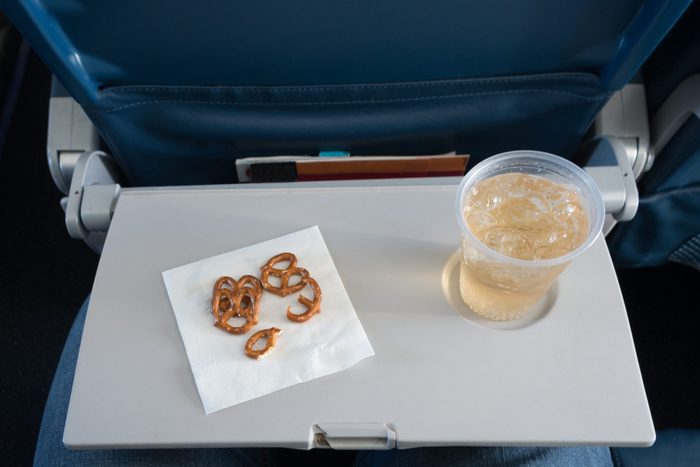
Skip the alcohol and caffeine
“While those cute little bottles of alcohol may be a temptation, they’re best avoided if you’re keen on optimizing your sleep and tackling jet lag,” says Dr. Chasser. She explains that alcohol may help you nod off, but it wreaks havoc on the quality of your sleep, leading to more frequent wake-ups and less restorative rest. “If you fancy a small tipple, try to ensure it’s six hours before your planned sleep, and always stay well-hydrated.”
Dr. Paulvin also says to focus on an anti-jet lag diet by eating healthy meals the days leading up to your trip. “On the day of, try to avoid caffeine before your flight—this will make it easier to sleep,” he says.
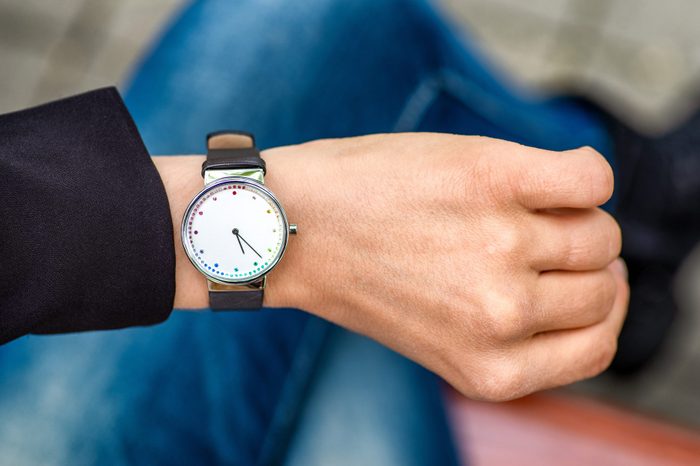
Get in sync with your destination
Tune your body to your future time zone. “During the flight, the most important thing is to focus on the time at your destination,” she says. “Once you’re airborne, switch your watch to your destination’s time zone and start living on that clock. If it’s nighttime where you’re heading, try to mimic that on the plane,” she says, even if that means skipping meals and in-flight entertainment.
“If it’s daytime at your destination, you should try to limit the amount of sleep you get,” Dr. Chasser says. A short nap is OK, but otherwise, “keep the lights on and remain as active as possible. Walking around the plane and having regular meals will signal to those internal body clocks they should be in daytime mode.”
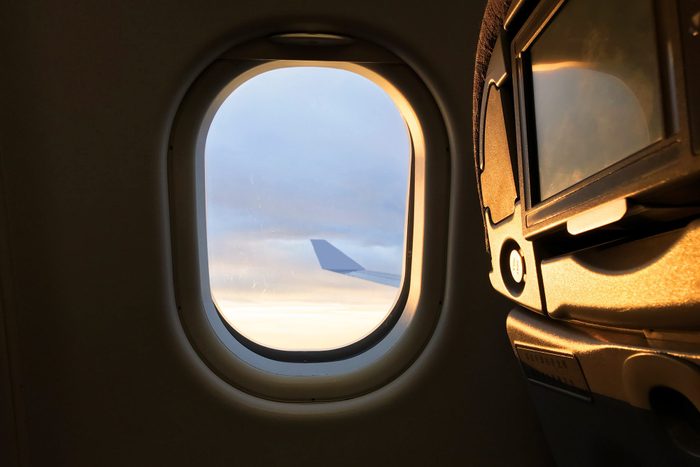
Book a window seat
If you can’t snag an upgrade, booking a window seat is the next-best option if you want to learn how to sleep on a plane. It’s easier to fall asleep because you can rest your head on the window, and you won’t be woken up by a fellow passenger heading to the airplane bathroom. Plus, you’re in charge of the window shade.
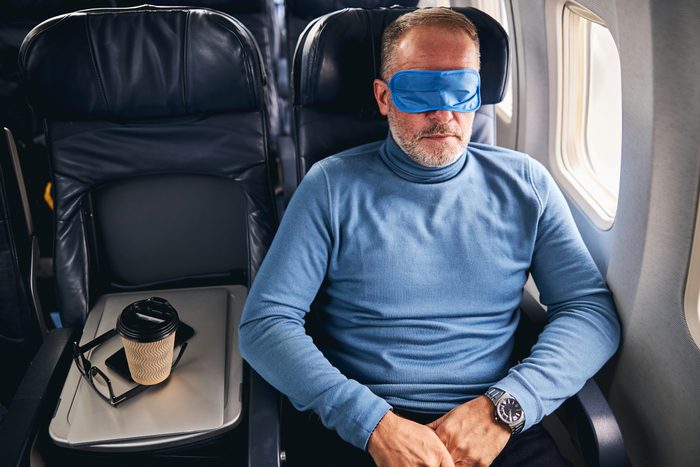
Bring a light-blocking eye mask
Whether it’s an open shade, interior lighting or your neighbor’s reading light, well-lit flights can prevent restful sleep. Want to know how to sleep on a plane with bright light? Just block it out. A soft, comfortable light-blocking eye mask is recommended by Dr. Chasser, who likes the Kitsch Satin Sleep Mask, a silky wrap-around style. You can also try a slightly weighted sleep mask, which provides just a small amount of pressure to help relax your nerves.
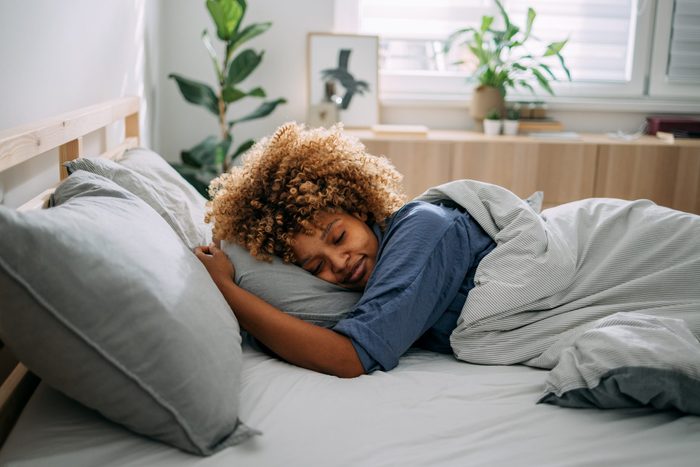
Stick to your bedtime routine
For author and travel journalist Tyler Wetherall, sleeping on planes is all about the ritual. “When it’s time to sleep, I prepare like I’m preparing for bed. I brush my teeth, I clean my face (even if it’s just a face wipe), I change into a comfortable airport outfit.” She puts on an eye mask and ear plugs or “headphones playing the most dry history podcast I can find.”
Dr. Chasser agrees that getting comfortable is essential, and it’s also good for your health. If you’re frequently cold on airplanes, make sure to dress in layers or bring a sweater. “Putting on cozy bed socks or even a beanie hat can help lower your central body temperature by encouraging blood to be diverted to the peripheries,” she says. “This is a key factor in signaling to your body that it’s time to start drifting off to sleep.”
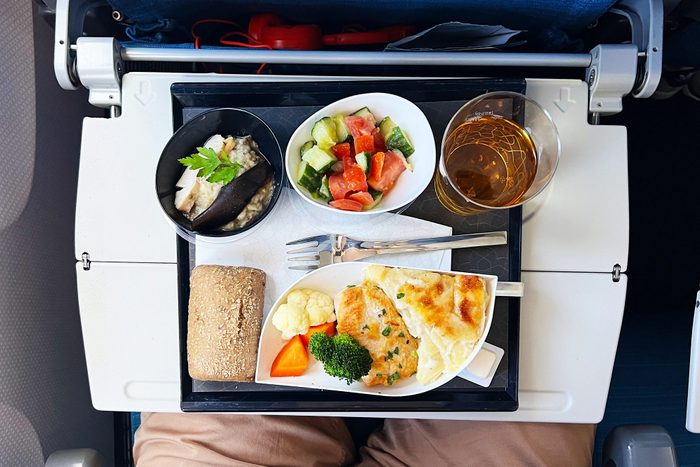
Opt out of the in-flight meal
If you’d like fewer sleep interruptions (and who wouldn’t?), consider skipping the in-flight meal, especially on overnight flights. As a travel writer, I fly frequently between Italy and the U.S., and my flight to Italy is always an over-nighter. But with the time change, I lose six hours en route. I board in the early evening and arrive in Italy early the next morning, usually with an 8-hour flight time. If I wait for the in-flight meal (which, let’s face it, is often just so-so) and for my tray to be collected afterward, two hours can easily go by. Instead, I’ve learned to have dinner in the airport before boarding (in an airport lounge when I can swing it). That way, I can settle into sleep as soon as the wheels go up.

Consider a sleep aid
Some fliers get right down to business, taking a sleep aid to help them snooze on the plane. For Wetherall, it’s a CBD gummie (where legal, of course), melatonin or a Tylenol PM, “depending on how desperate I am!”
Dr. Chasser says that melatonin can help you sleep on a plane, especially when you time your dose. “Melatonin is the hormone that helps your body know when it’s time to sleep and wake up. If you’re flying west and find you wake too early, taking a melatonin supplement in the morning on waking can help you sleep in a bit longer and help adjust your body clock.” On the other hand, she says, if you’re flying east, take melatonin about 30 minutes before (what would be) bedtime at your destination. “It not only nudges your body clock earlier, but it also has a mild sedative effect that will help you drift off.” Make sure the melatonin you take is the short-acting variety, and if in doubt, talk to your doctor first.
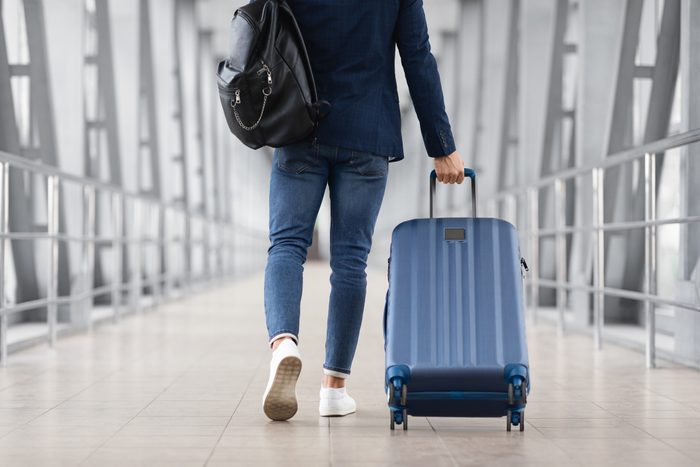
Pack the right travel tools
Getting comfortable is much easier with the right travel accessories in your carry-on bag. “The tools you bring onto your flight can create a comfortable sleeping setup at cruising altitude,” says Dr. Paulvin. That can include feet-warming socks, comfortable clothing, neck pillows, earplugs, noise-canceling headphones, sleep masks and more. “[These] can all help to turn your airplane seat into a more welcoming setting. Use everything at your disposal to feel at ease on the flight, and this will help you to relax and get quality sleep.”
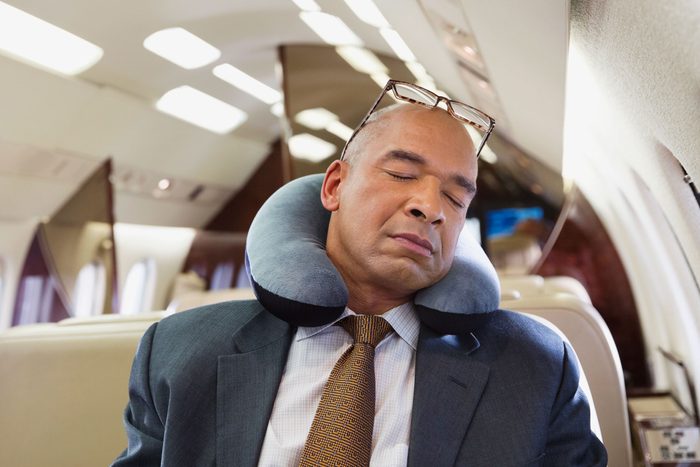
Invest in a good travel pillow
There’s nothing worse than head-bobbing as you doze off in an upright plane seat. If you don’t startle yourself awake when your head drops, you’re certain to wake up with a sore neck. But all travel pillows are not created equal, and this is one travel accessory you don’t want to skimp on. Dr. Chasser recommends the Cabeau Evolution S3 Travel Neck Pillow because of its memory-foam construction. I have this travel pillow and can attest: My family and I fight over it when we fly together. Other experts swears by the Trtl Travel Pillow, which looks more like a neck scarf but puts an end to head-bobbing.
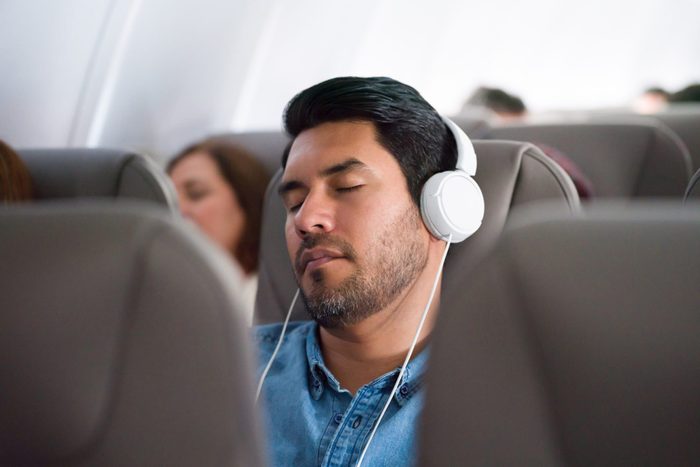
Tune out with headphones
Noise-blocking headphones or earplugs will help you relax in relative silence, which is especially needed on a flight with noisy passengers. While the packaged headphones provided by some airlines might do in a pinch, they’re usually not comfortable, and their long cords get tangled in your seat belt and tray table. Frequent travelers say it’s worth bringing your own wireless headphones, both as a question of performance and comfort.
For over-ear headphones, Dr. Chasser prefers Sony Wireless Noise Canceling Headphones. For in-ear options, she recommends Bose QuietComfort Earbuds II.
About the experts
- Caitlin Chasser is a general practitioner and co-founder of The Sleep Project, a source for better understanding the intricate science and art of sleep. For those navigating the challenges of achieving quality sleep while airborne, the expert tips from Dr. Chasser and her team aim to help individuals recharge their life with better sleep.
- Neil Paulvin, DO, is a New York–based innovative physician in the study of functional medicine, integrative sports medicine, regenerative medicine, osteopathic manipulation and craniosacral therapy. Dr. Paulvin uses an integrative approach to help patients optimize their health, improve their performance and heal from illness and injury.
- Tyler Wetherall is a writer, editor, teacher and author. As a journalist, her work has appeared in The Guardian, National Geographic, Vice and Condé Nast Traveler.